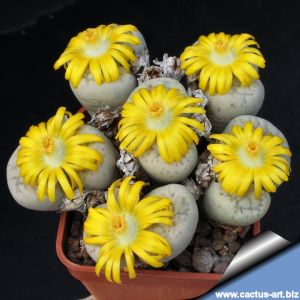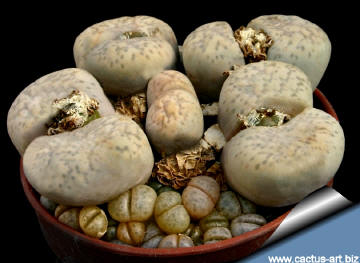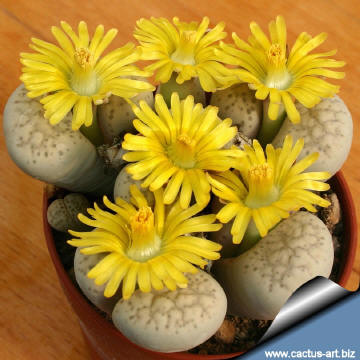-
x
Description
It is on of the latest species to flowers in November through n December. It is easily recognizable for the very numerous dull grey-green dots on an opaque beige, grey-white or cream body. Family: Mesebrianthemaceae (Aizoaceae) Origin: It is found in a restricted range and small population in the Lüderitz district, Namibia. Mesebrianthemum francisci Dint. & Schwant (basionym) Habitat: Its natural habitats are rocky areas and cold desert. The stones comprises: gneiss and schist. The colour of the background varies from light grey-white to light brown, with some black. Conservation status: Listed in CITES appendix 2. Common English Names include: Stone plant, Living stone. Etymology: Named After Frantz de Laet of Contich (near Antwerp), Belgium.
| |
| Description: L. franciscii is generally smaller than most Lithops and (especially in cultivation) tends to grow not buried in the ground and often shows an elongated shape rather than the classical underground cordate (heart-shaped) form. It is easily recognizable for the very numerous dull grey-green dots on an opaque beige, grey-white or cream body often with yellow, green or pink nuances. It can form quite large groups with up to 20 or more heads, but usually it as only 3 to 6 heads. This species grows quickly from seed and flower easily. | |
| | |
Cultivation: Need an open mineral, fast draining mix and the maximum amount of light you are able to give them. The basic cultivation routine is: Stop watering after flowering. Start watering after the old leaves completely dry. (Usually late March or Early April) Water freely during the growing season, soak the compost fully but allow it to dry out between waterings, no water when cold. Some growers fertilize frequently, some hardly ever. Keep them dry during the winter. Nearly all problems occur as a result of overwatering and poor ventilation especially when weather conditions are dull and cool or very humid. This plant is best for a well lit area (Bright shade to full sun). | |


 Lithops franciscii C140 TL: 35 km East of Lüderitz, Namibia
Lithops franciscii C140 TL: 35 km East of Lüderitz, Namibia 




